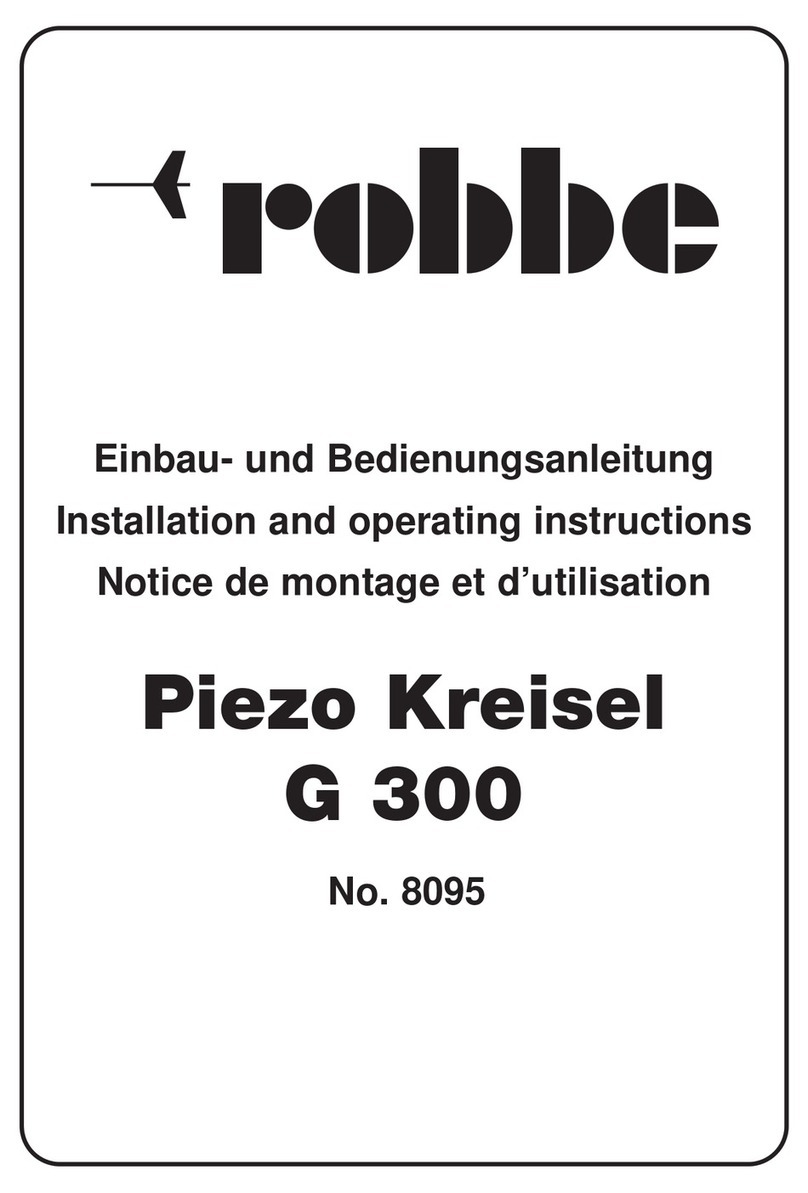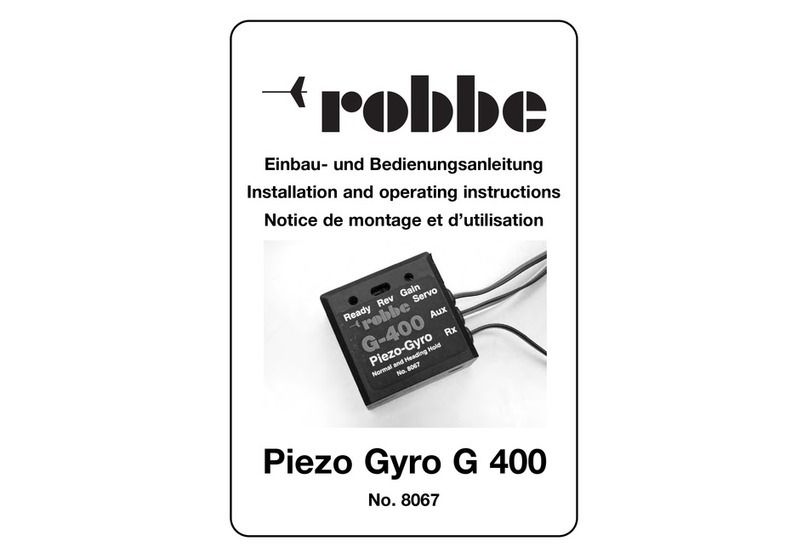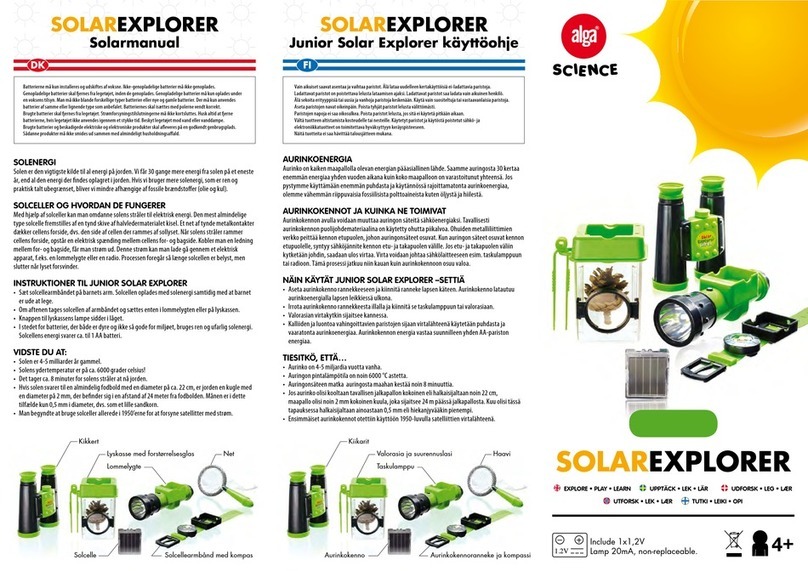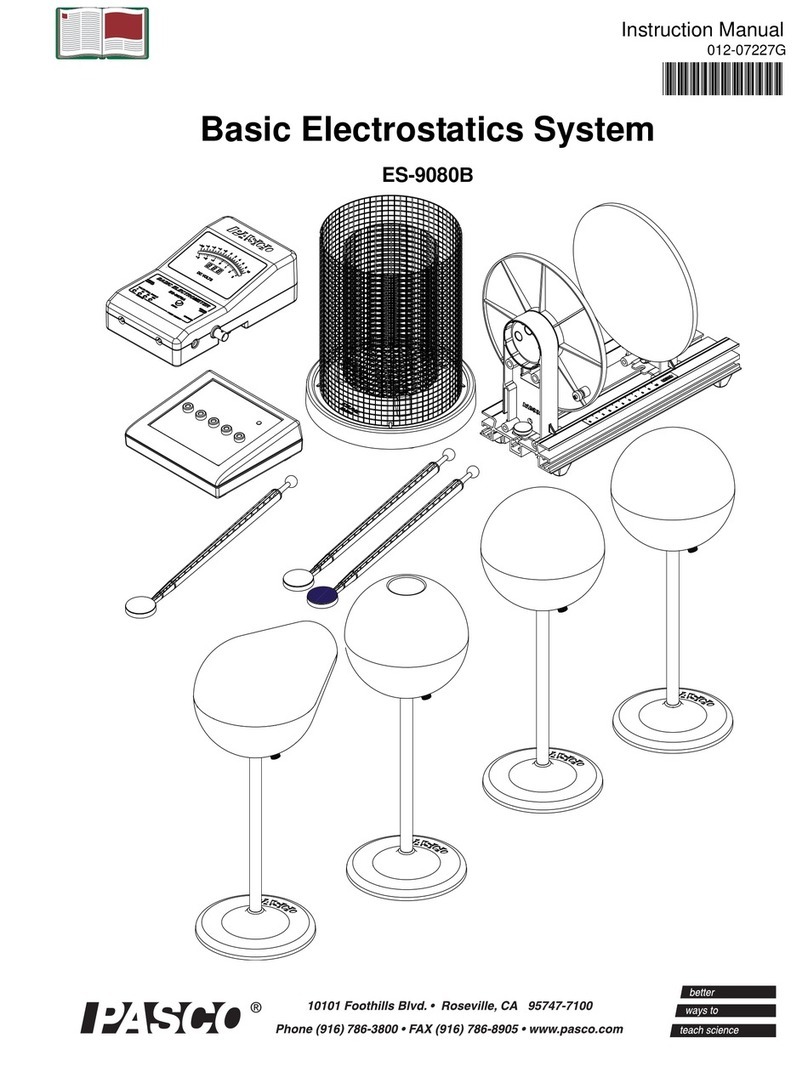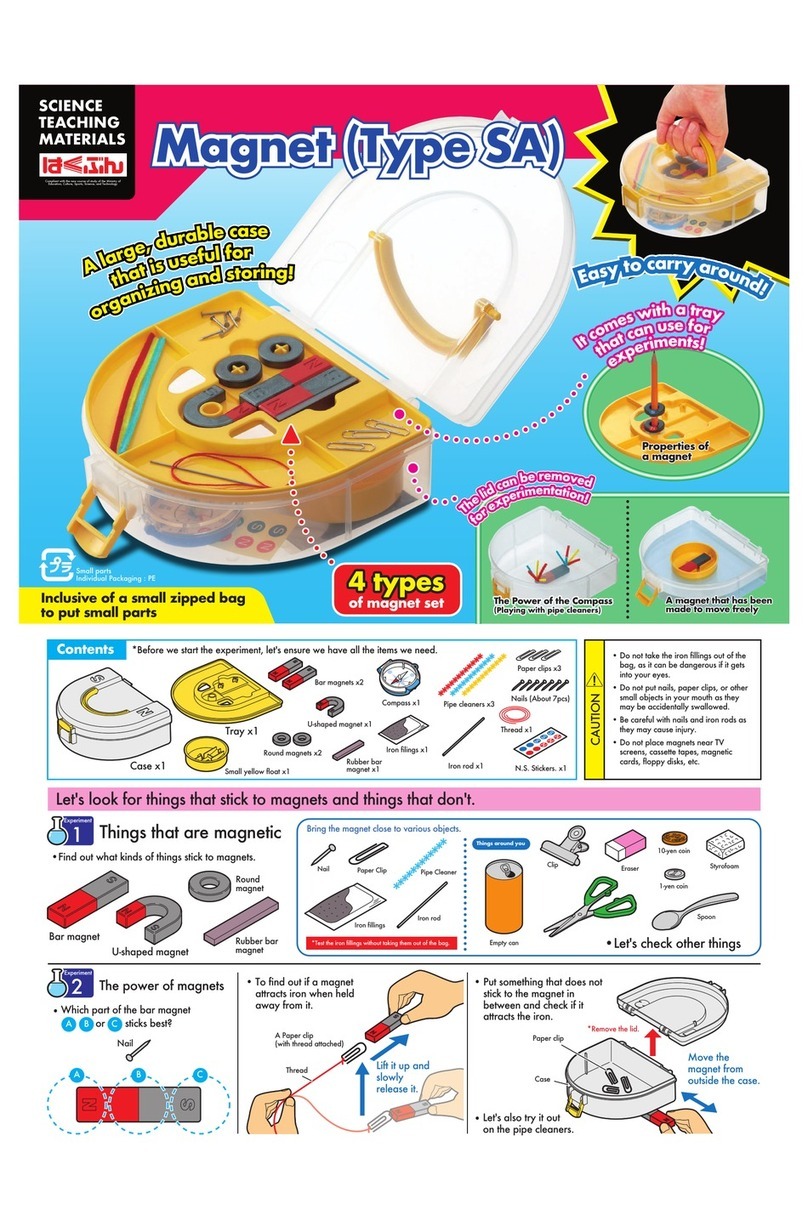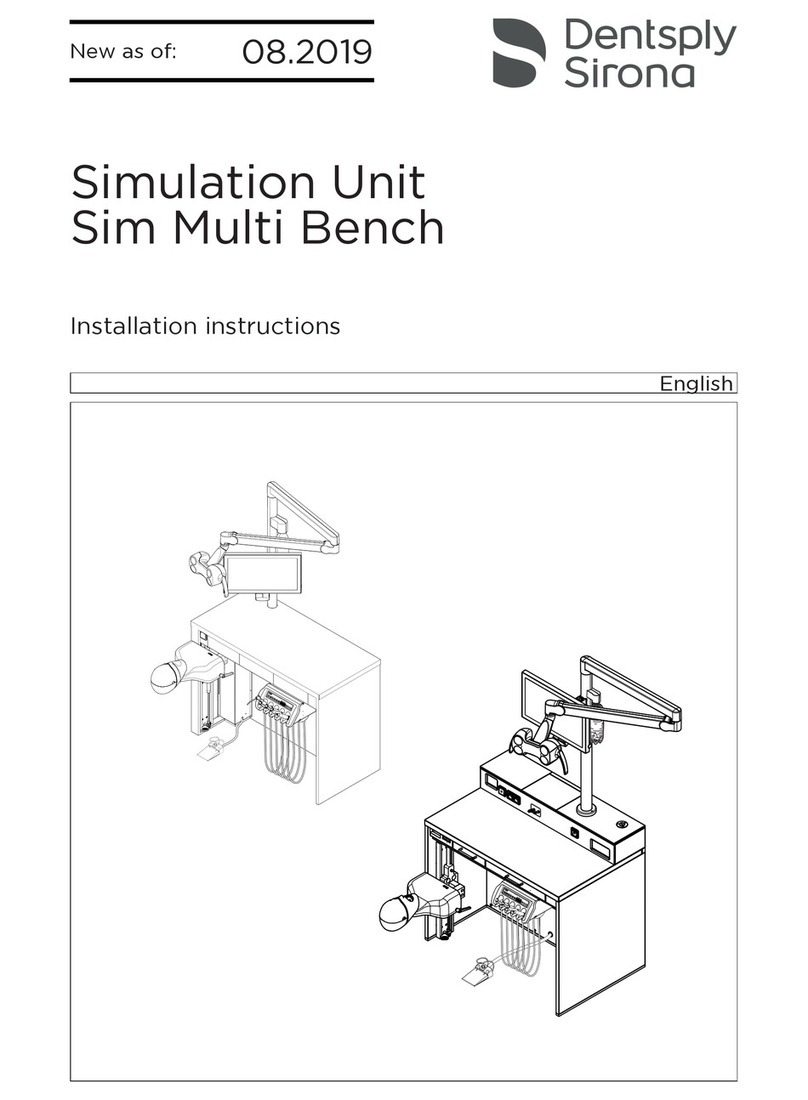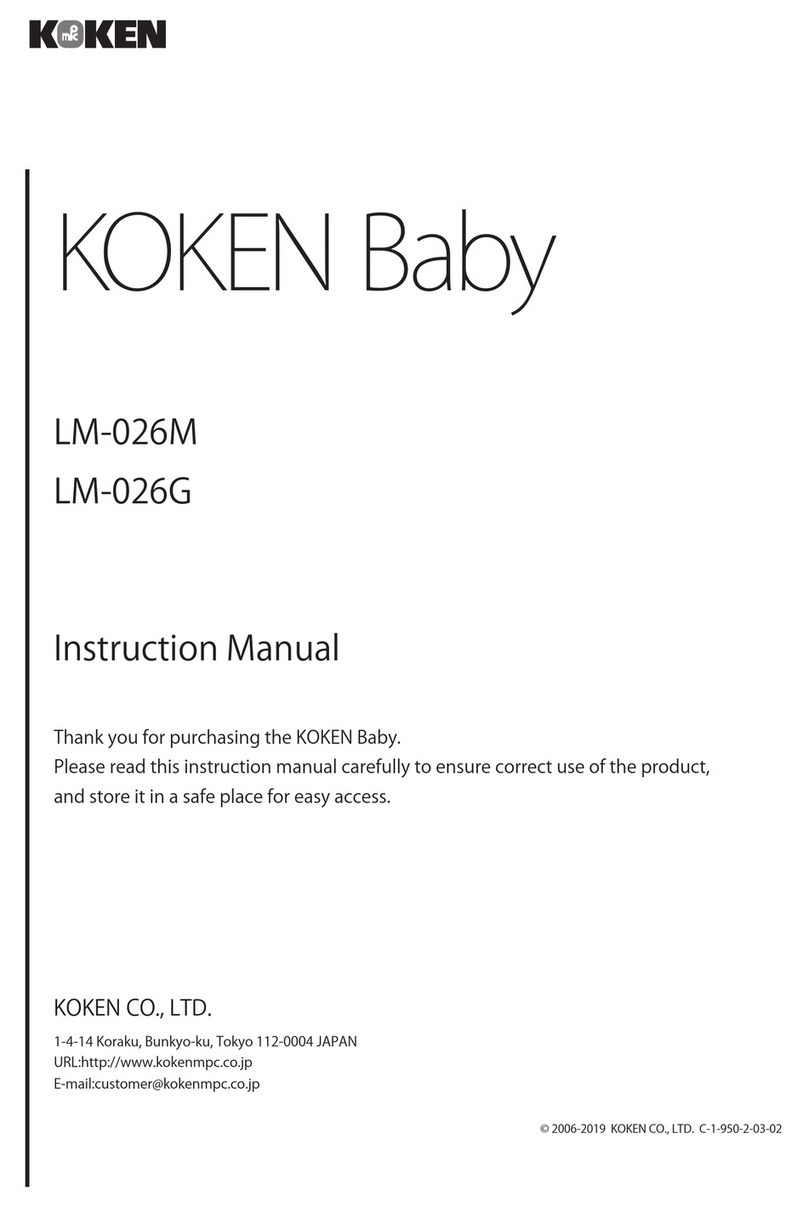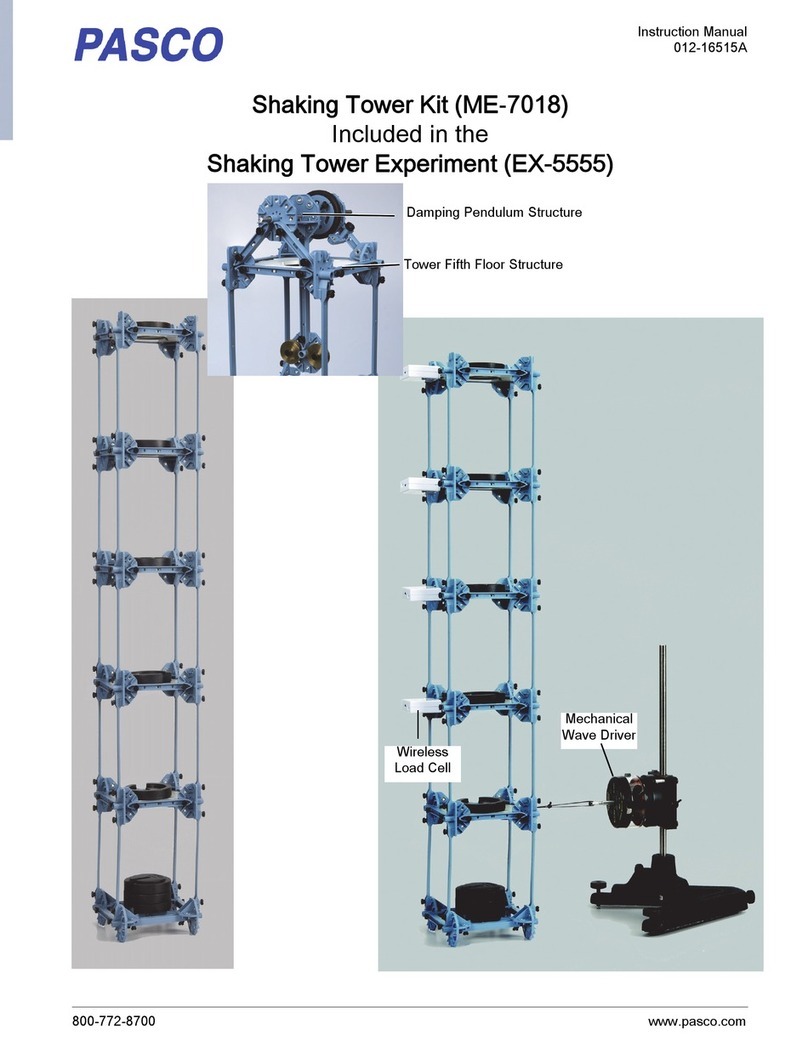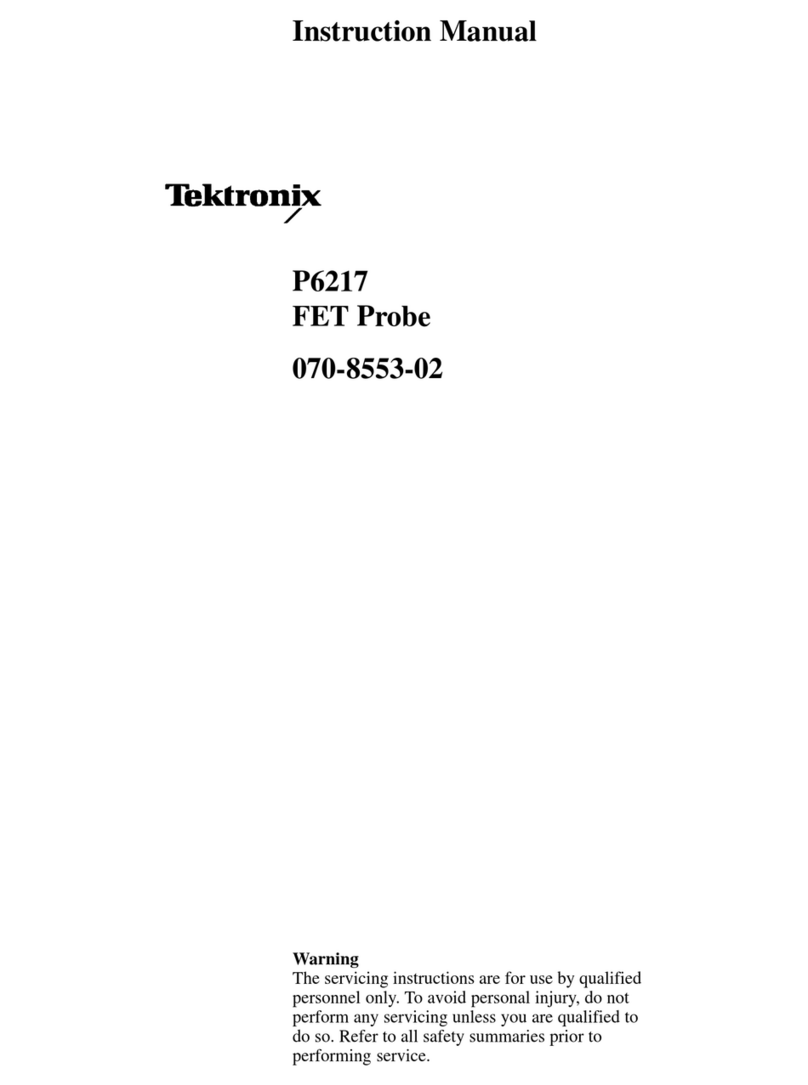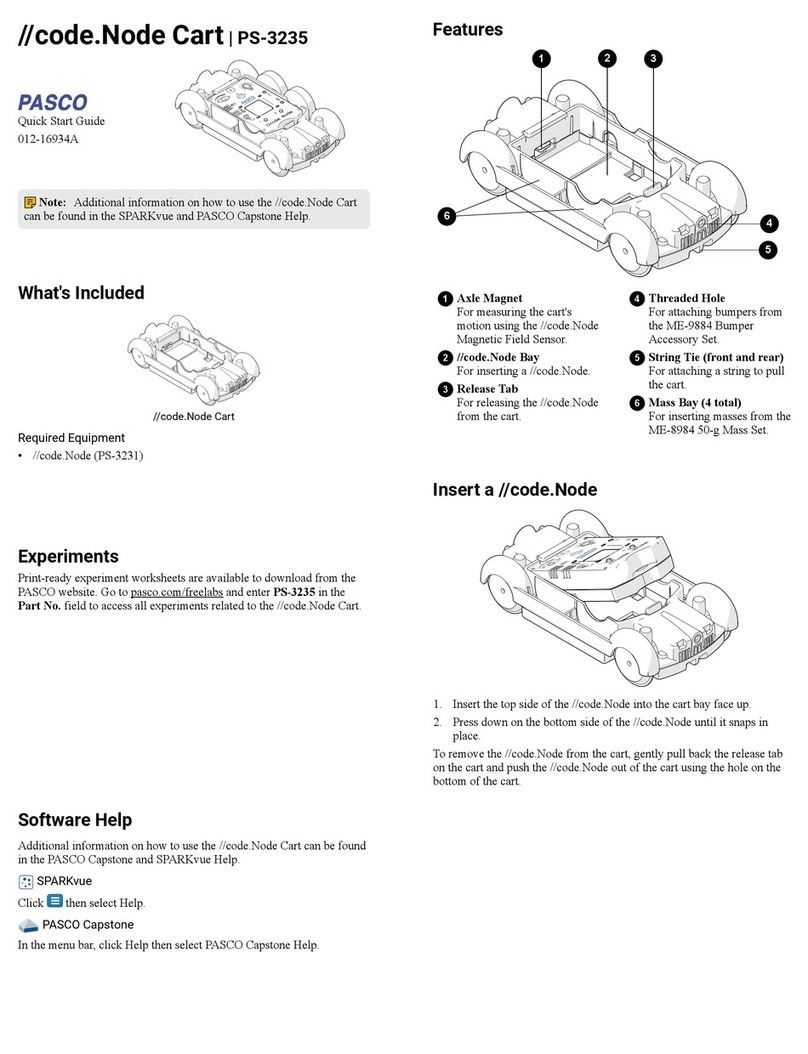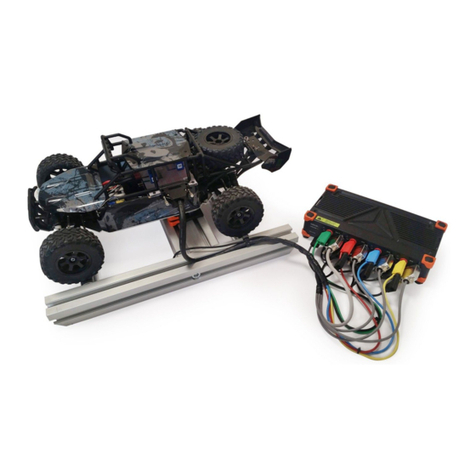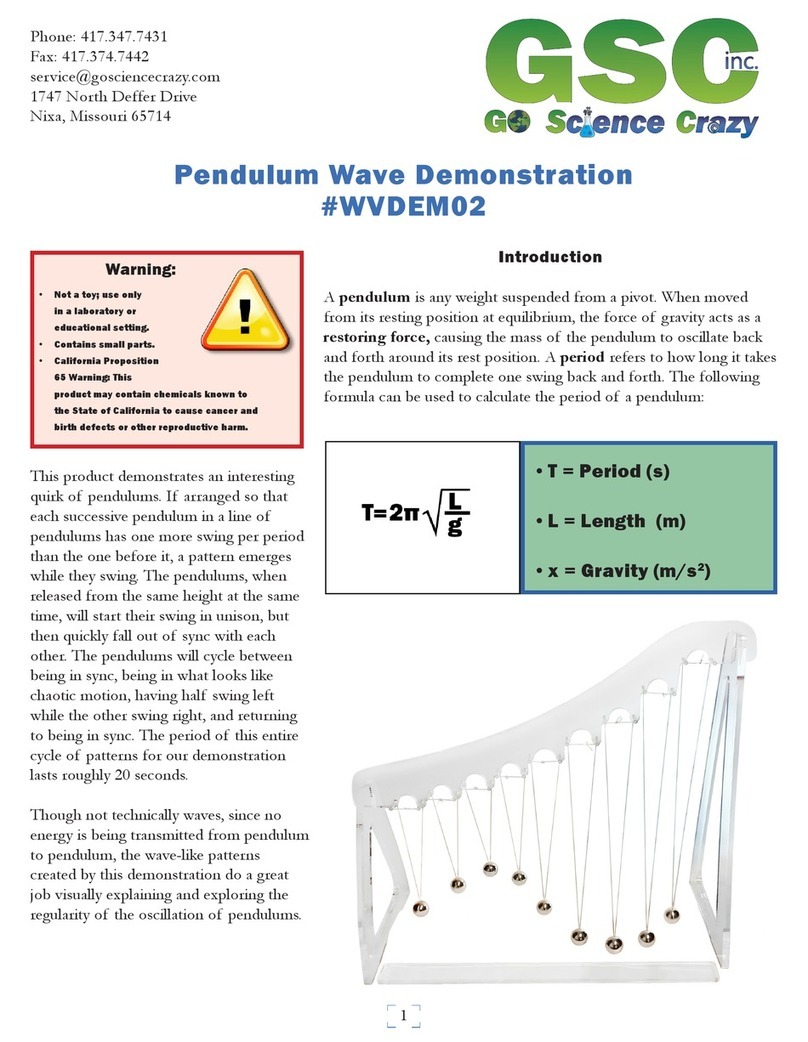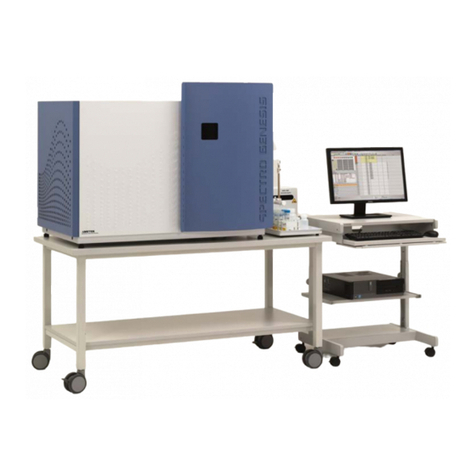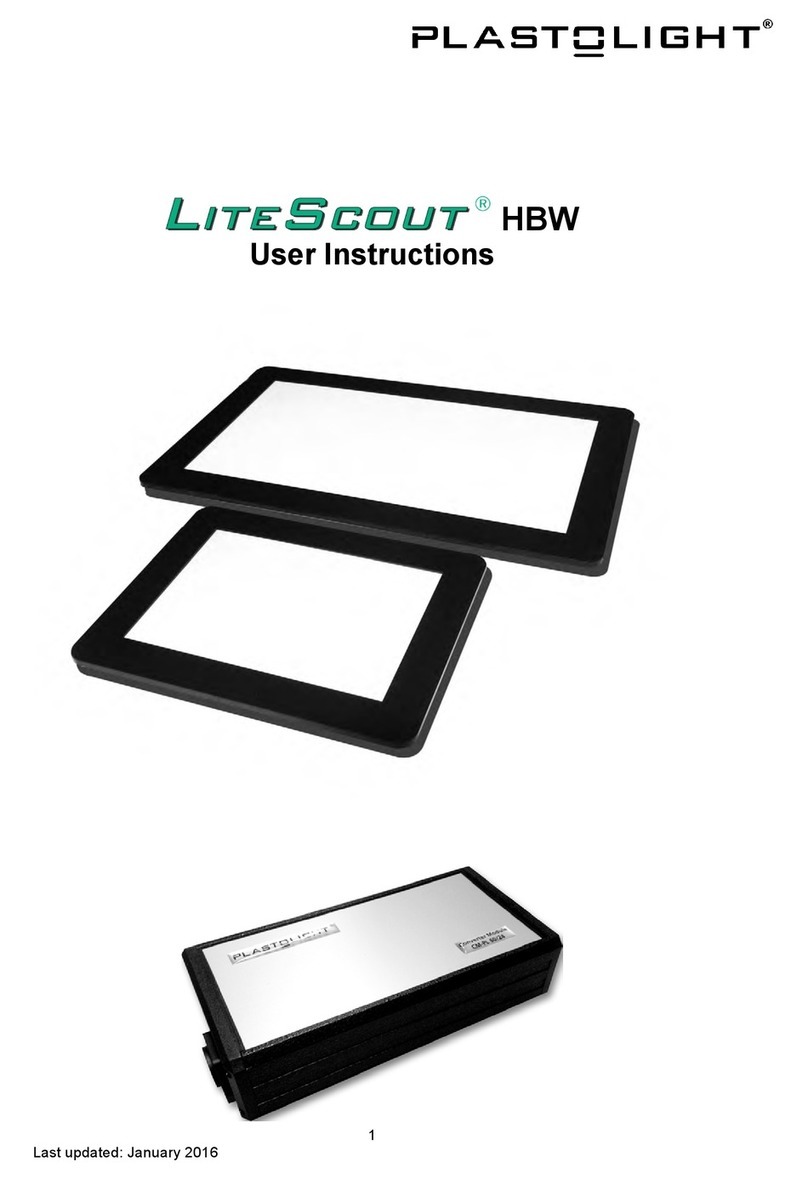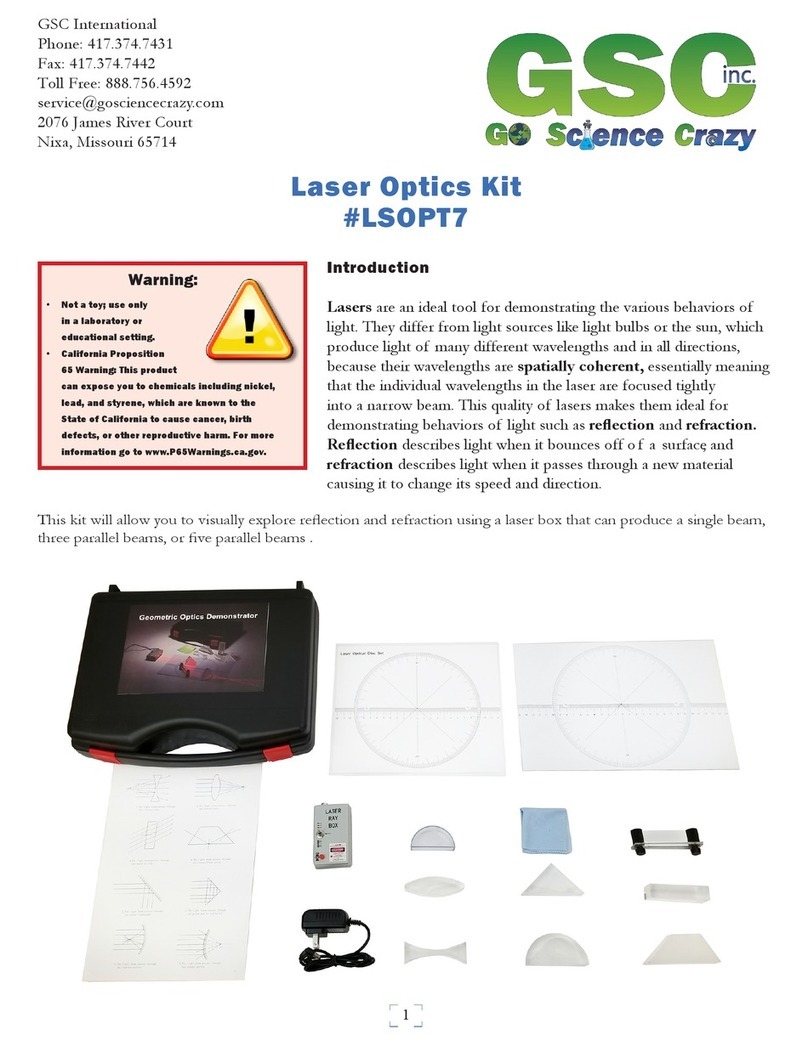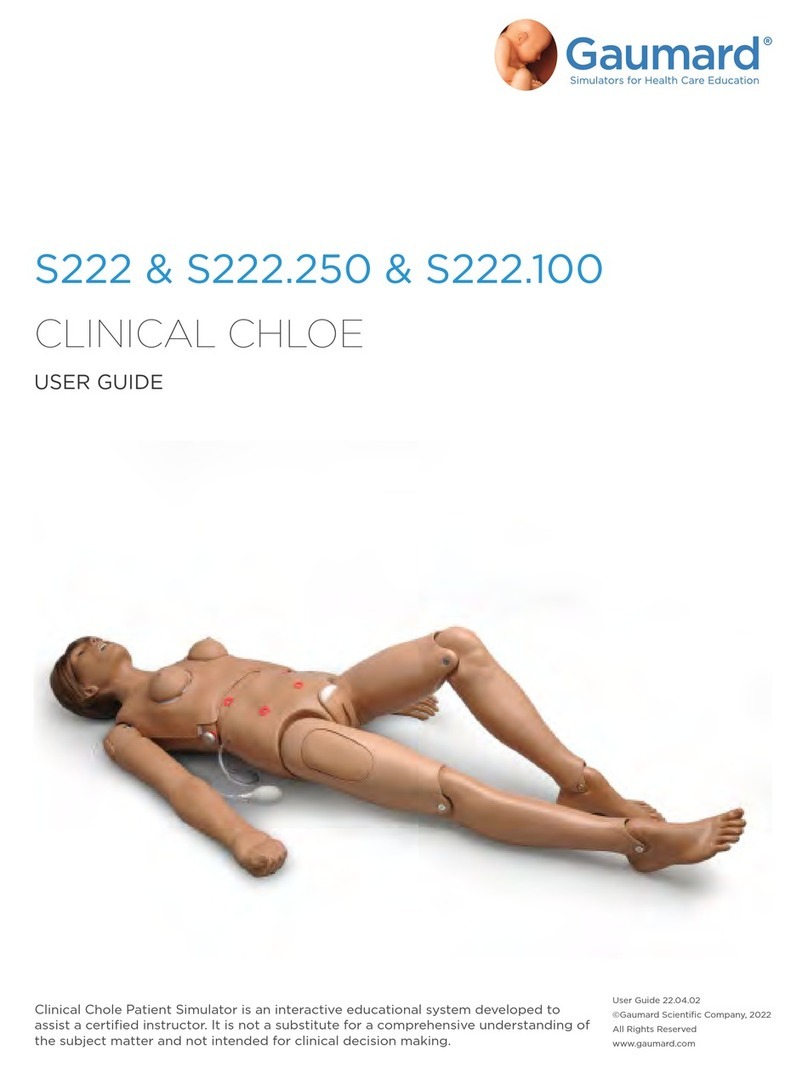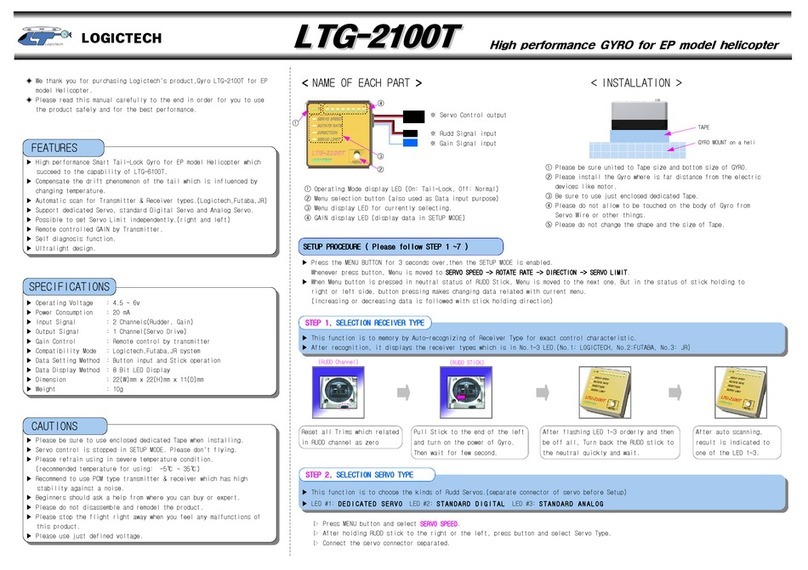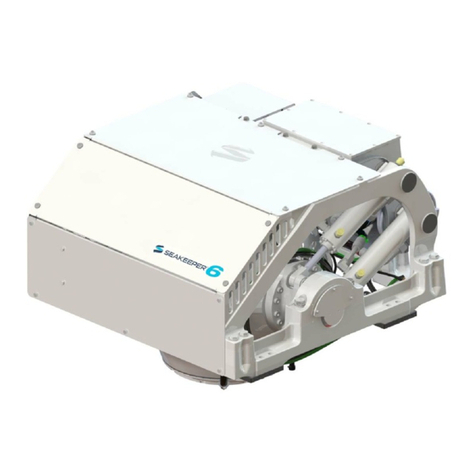ROBBE 8065 User manual

Einbau- und Bedienungsanleitung
Installation and operating instructions
Notice de montage et d’utilisation
No. 8065
3D GYRO

No.
8065
3D GYRO
2
Inhaltsverzeichnis - Contents - Contenu résumé
Einbau und Bedienungsanleitung 3D-GYRO (deutsch) Seite 3 - 9
Installation and operating instructions 3D-GYRO (english) page 10 - 16
Notice de montage et d’utilisation 3D-GYRO (française) page 17 - 23
Für Ihre Notizen - Notes - Pour prendre des notes

No.
8065
3
3D GYRO deutsch
Achtung: Neues Funktionsprinzip, Anleitung vor Inbetriebnahme des Gerätes
unbedingt lesen
1. Vorwort:
Der robbe 3-D Gyro ist ein revolutionäres Präzisions - Kreiselsystem mit Piezo - Sensor für
Flug und Hubschraubermodelle.
Dieser moderne Piezo - Kreisel besitzt 2 unterschiedliche Modi:
· Normaler Modus
In diesem Modus erfolgt die Stabilisierung einer Achse ( z.B. Heckrotor) wie bei bisherigen
Kreiselsystemen. Wird das Modell durch äußere Einflüsse wie Wind, schnelle
Drehzahländerung oder Pitchänderungen aus seiner Lage gebracht, so wird über den
Piezo - Sensor dieser Wert gemessen als Steuersignal umgeformt und dem Heckrotor -
Servo als Korrekturwert zugeführt, um die Differenz auszugleichen.
· Heading Hold Modus
Heading Hold bedeutet soviel wie „Richtung halten“. In diesem Modus arbeitet der 3-D Gyro
zunächst wie ein normaler Kreisel, zusätzlich aber „merkt“ sich der Kreisel seine derzeitige
Lage. Wird das Modell nun um die Kreiselachse, durch äußere Einflüsse wie Wind etc., aus
seiner Lage gebracht, summiert die Elektronik diese Abweichungen auf und steuert das
Modell in seine ursprüngliche Lage zurück. Dieses Zurücksteuern erfolgt so schnell, daß
eine Auslenkung fast nicht zum Tragen kommt. Das Modell steht wie „angenagelt“ in seiner
gesteuerten Position. Völlig gleich, ob quer
zum Wind, Wind im Rücken, auf dem Rücken
etc.. Der 3-D Gyro versucht unter allen
Umständen diese Position beizubehalten.
Hinweis:
Um die maximale Leistung zu erreichen, sollte
der 3D-Gyro in Verbindung mit einem sehr
schnellen Servo für die Heckrotorsteuerung
betrieben werden. Selbstverständlich können
auch Servos mit normaler Stellgeschwindigkeit
eingesetzt werden. Allerdings sind die
Stabilisierungsergebnisse dann nicht so per-
fekt wie mit den superschnellen Servos.
Servoempfehlung:
Betrieb mit 4,8 Volt (4 NC)
Servo S 9203 Bestell - Nr. F 1264
Betrieb mit 6 Volt (5 NC)
Servo S 9402 Bestell - Nr. F 1253
3D
GYRO
Ready Rev Gain
Servo
Aux
Rx
Piezo Gyro with
Headling Hold
No. 8065
Made in Germany
1
2
3
4
5
6
7
8
Receiver
35 MHz
Kan. 4
Kan. 5
Skizze 1

No.
8065
4
3D GYRO deutsch
2. Für ganz eilige, Kurzanleitung zur ersten Inbetriebnahme:
· Anschluß gemäß Skizze 1 vornehmen
· Sender einschalten
· Empfänger einschalten
· Modell bzw. 3-D Gyro ca. 10 Sekunden nicht bewegen, 3-D Gyro führt seinen
Nullabgleich durch.
·Abgleich fertig -> Heckrotor - Servo läuft aufAusgangsstellung und die rote LED ”Ready“
am 3-D Gyro leuchtet
· Schieberegler Kanal 5 in eine Endposition bringen
· Heckrotor - Steuerknüppel in eine Endstellung bringen und loslassen
· Geht das Servo wieder auf seine ursprüngliche Position zurück -> Normal Modus
· Bleibt das Servo an dieser Stelle stehen -> Heading Hold Modus
· Der Schieberegler 5 wirkt als „Umschalter“ zwischen den beiden Modi und gleichzeitig als
Empfindlichkeitseinsteller.
· Bei Mittelstellung: 0%
· Bei Stellung Richtung: I 0% - 100% „Normal“ Modus
· Bei Stellung Richtung: II 0% - 100% „Heading Hold“ Modus
LINEAR
100 %
0 %
100 %
Normal Modus
Heading Hold Modus
I
II
Skizze 2

No.
8065
5
3D GYRO deutsch
3. Einbau
Wichtig: Alle Kreiselsysteme mit Piezo - Sensoren sind empfindlich gegen Vibrationen. In
einem vibrationsbelasteten Modell werden Sie mit keinem Piezo - Kreisel zufriedenstellen-
de Ergebnisse erzielen. Mit den beiliegenden Schaumstoffteilen können Sie das
Kreiselsystem auf Ihr Modell anpassen. Gute Ergebnisse wurden auch mit dem 3,2 mm
dicken Doppelklebeband von 3M (robbe Bestell - Nr. 5014) erzielt. Deshalb empfehlen wir
Ihnen dringend, diesem Punkt besondere Aufmerksamkeit zu schenken.
Kleben Sie einen der mitgelieferten selbstklebenden Schaumstoffstreifen auf die Unterseite
des Kreisel - Gehäuses. Plazieren Sie das Gehäuse nun an einer vibrationsarmen Stelle
im Modell (beim Futura z.B. im Dom unter dem Pitchservo). Der Kreisel ist so einzubauen,
daß die zu stabilisierendeAchse senkrecht durch den Kreisel verläuft ( siehe Skizze 3). Die
Einbauposition ist unkritisch, ob in der Nähe der Rotorwelle oder am Servovorbau, wichtig
ist nur, daß der 3-D Gyro gegen Vibrationen gut geschützt ist.
ReadyRevGain
Servo
Aux
Rx
3D
GYRO
ReadyRevGain
Servo
Aux
Rx
3D
GYRO
ReadyRevGain
Servo
Aux
Rx
3D
GYRO
Stabilisierung der Hochachse
Stabilisierung der Längsachse
Stabilisierung der Querachse
Skizze 3

No.
8065
6
3D GYRO deutsch
4. Anschluß und Inbetriebnahme
Hinweis: Sobald der Aux-Kanal angeschlossen wird, ist der Regler Gain außer Funktion.
4.1. Anschluß und Abstimmung des 3-D Gyro für „ Normal Modus“ mit Empfindlich-
keitseinstellung vom Sender aus
Stabilisierung des Heckrotors wie bei bisherigen Piezo Kreiselsystemen. Dieser Modus ist
geeignet für normales Fliegen, sowie zum Training von Kunstflugfiguren. Im Gegensatz, zu
dem später beschriebenen Heading Hold Modus, wird sich der Heckausleger des Modells
durch den Windfahneneffekt in den Wind drehen.
Wichtig:
· Der 3-D Gyro erkennt und korrigiert kleinste Abweichungen, so daß er keine Unter-
stützung durch einen Pitch -> Heckrotor Mischer (Revo-Mix) benötigt, wir empfehlen die
sen Mischer auszuschalten.
· Um schnelle Pirouetten zu steuern, wurde bei herkömmlichen Kreiselsystemen die
Empfindlichkeit elektronisch ausgeblendet (Gyro-Sens-Mischer). Dies ist bei dem 3D -
Gyro nicht mehr erforderlich, denn hier wird das Sensorsignal vom Steuerknüppel
übersteuert. Wie stark es übersteuert wird, legt man über die Servowegreduzierung (ATV)
fest. Deshalb muß der Ausblendmischer (Gyro-Sens) unbedingt ausgeschaltet werden.
· Ebenfalls sind alle anderen Mischfunktionen die auf den Heckrotor wirken abzuschalten
(z.B. Mischer Taumelscheibe -> Heckrotor)
Wie in der Skizze 1 gezeigt, den 3-D Gyro zwischen das Heckrotorservo und den
Empfänger stecken und den Anschluß „Aux“ an einen freien Schieberkanal ( z.B. Kanal 5 )
anschließen.
· Sender einschalten.
· Empfänger einschalten.
· Modell bzw. 3-D Gyro ca. 10 Sekunden nicht bewegen, 3-D Gyro führt Nullabgleich
durch.
·Abgleich fertig -> Heckrotorservo läuft auf Ausgangsstellung und die rote LED ”Ready“
am 3-D Gyro leuchtet.
· Sollte das Modell trotzdem bewegt worden sein, oder die Kontroll - LED blinken, so muß
zur erneuten Initialisierung die Empfängerstromversorgung aus - und wieder eingeschal-
tet werden.
· Schieberegler Kanal 5 in eine Endposition bringen.
· Heckrotor - Steuerknüppel in eine Endstellung bringen und loslassen.
· Geht das Servo wieder auf seine ursprüngliche Position zurück -> Normal Modus.
· Bleibt das Servo stehen, so befindet sich der Kreisel im Heading Hold Modus, Schieber 5
auf entgegengesetzte Endposition bringen.
· Heckrotortrimmung in die Mitte stellen.
· Servohebel mechanisch so anbringen, daß der Arm nahezu 90° zum Gestänge steht.
· Gestänge am Heckgetriebe in das äußerste Loch einhängen.
· Heckrotor Steuerknüppel auf Vollausschlag stellen.
· Gestänge am Servohorn so einhängen, daß sich der maximale Steuerweg ergibt aber
kein mechanischer Anschlag am Heckrotor erfolgt.

No.
8065
7
3D GYRO deutsch
· Kontrolle der Servo Laufrichtung: Heckrotor Steuerknüppel nach rechts bewegen, gehen
die Vorderkanten der Heckrotorblätter nach links? Wenn nicht, Servo Reverse am Sender
durchführen.
· Kontrolle Wirkrichtung Kreisel (Schalter REV) : Heckausleger nach rechts bewegen,
gehen die Vorderkanten der Heckrotorblätter nach links? Wenn nicht, den Schalter „REV“
am 3-D Gyro umschalten. Hinweis: Umschaltung erfolgt erst nach erneutem Aus -
Einschalten des Kreisel (Angaben in Flugrichtung).
Nun kann über den Schieberegler 5, vom Sender aus die Empfindlichkeit stufenlos von 0 -
100 % eingestellt werden.
Hinweis: Im Gegensatz zu den bisherigen Kreiselsystemen wird beim 3-D Gyro mit der
Kreiselempfindlichkeit auch der Servoweg reduziert, da bei geringerer
Kreiselempfindlichkeit auch ein kleinerer Heckrotorsteuerweg (bei gleicher Steuerfolgsam-
keit) benötigt wird. Der Kreisel besitzt zudem eine exponentielle Steuercharakteristik. Eine
Einstellung von unter 30 % ist nicht praxisgerecht und sollte nicht vorgenommen werden,
weil sich der Heckrotorsteuerweg deutlich reduziert.
Um sich beim 1. Flug an den Kreisel zu gewöhnen, empfehlen wir folgende
Grundeinstellwerte:
· Servowegeinstellung Heckrotor (ATV) : ca. 70 %
· Kreiselempfindlichkeit (ATV): ca. 70 %
4.2. Anschluß und Abstimmung des 3-D Gyro für „Heading Hold Modus“ mit
Empfindlichkeitseinstellung am Sender
Wie bereits eingangs beschrieben, wird in diesem Modus sehr gut die Heckauslegerposi-
tion beibehalten. Dieser neue Modus bietet folgende Vorteile:
· Für den Einsteiger ergibt sich nun die Möglichkeit, sich völlig auf die anderen Grundfunk-
tionen des Hubschraubers zu konzentrieren. Denn das Heck steht immer in der einmal
eingestellten Position.
· Bei Übungen quer zum Wind braucht der Heckrotor nicht nachgesteuert werden. Das
Modell fliegt ohne Windfahneneffekt. Das heißt, der Heckausleger wird sich nicht in den
Wind drehen. Um „geradeaus zu fliegen“ ist es nun allerdings erforderlich mit leichten
Steuerknüppelkorrekturen den Hubschrauber in die gewünschte Position zu stellen.
· Ideal für das seit geraumer Zeit immer mehr in Mode kommende 3D Fliegen, bzw. rück
wärts Fliegen, da das Heck nicht nachgesteuert werden muß. Eine einmal gewählte
Richtung bleibt erhalten.
Wichtig:
· Der 3-D Gyro erkennt und korrigiert kleinste Abweichungen, so daß er keine Unter
stützung durch einen Pitch -> Heckrotor Mischer (Revo-Mix) benötigt. Der Mischer
muß ausgeschaltet werden.
· Um schnelle Pirouetten zu steuern, wurden bei herkömmlichen Kreiselsystemen die
Empfindlichkeit elektronisch ausgeblendet (Gyro-Sens-Mischer). Dies ist bei dem 3D -
Gyro nicht mehr erforderlich, denn hier wird das Sensorsignal vom Steuerknüppel über
steuert. Wie stark es übersteuert wird legt man über die Servowegreduzierung (ATV)
fest. Deshalb muß der Ausblendmischer (Gyro-Sens) unbedingt ausgeschaltet werden.
· Ebenfalls sind alle anderen Mischfunktionen die auf den Heckrotor wirken abzuschalten.
(z.B. Mischer Taumelscheibe -> Heckrotor)

No.
8065
8
3D GYRO deutsch
Zur Inbetriebnahme wie unter 4.1 beschrieben vorgehen.
· „Heading Hold“ Modus aktivieren (Schieberkanal 5 auf Anschlag).
· Auf den Heckrotor achten, je nach Neutralimpuls der Fernsteuerung läuft er in eine
Richtung weg.
· Über die Trimmung kompensieren, bis der Heckrotor bzw. das Servo stehen bleibt (TIP:
wenn möglich die Trimmung elektronisch reduzieren (z.B. TRIM RATE 30 - 40 %) um fein
fühliger justieren zu können.
· „Normal“ Modus aktivieren.
· Modell in den Schwebeflug bringen, Nase in den Wind drehen.
· Wenn sich das Modell im Schwebeflug um die Hochachse wegdreht, landen und das
Heckgestänge - nicht die Trimmung - nachjustieren.
· Diesen Vorgang ggf. mehrmals wiederholen.
· Wenn das Modell nun um die Hochachse nicht mehr wegdreht, ist die mechanische und
die elektronische Seite des Modells aufeinander angepaßt.
Nun kann im „Normal“ bzw. „Heading Hold“ Modus zum Rundflug gestartet werden. Alle
weiteren Einstellungen wie die maximale Kreiselempfindlichkeit und die Servowegeinstell
ung für den Heckrotor (ATV) (max. Drehgeschwindigkeit) müssen erflogen werden!
· Über den Schieberegler (z.B. Kanal 5), kann vom Sender aus die Empfindlichkeit stufen
los von 0 - 100 % eingestellt werden.
Hinweis: Im Gegensatz zu den bisherigen Kreiselsystemen wird beim 3-D Gyro mit der
Kreiselempfindlichkeit auch der Servoweg reduziert, da bei geringerer Kreiselempfindlich-
keit auch ein kleinerer Heckrotorsteuerweg (bei gleicher Steuerfolgsamkeit) benötigt wird.
Der Kreisel besitzt zudem eine exponentielle Steuercharakteristik. Eine Einstellung von
unter 30 % ist nicht praxisgerecht und sollte nicht vorgenommen werden, weil sich der
Heckrotorsteuerweg deutlich reduziert.
4.3. Anschluß des 3-D Gyro im „Normal Modus“ mit manueller Empfindlichkeitsein-
stellung am Kreisel.
Bei Fernsteueranlagen mit geringer Kanalzahl, steht häufig kein freier Kanal zur Einstellung
der Kreiselempfindlichkeit zur Verfügung. In diesem Falle den Anschluß „Aux“ des Kreisels
nicht anschließen. Nun kann über den im Kreisel befindlichen Regler ”Gain“ die
Empfindlichkeit stufenlos von 0 - 100 % eingestellt werden, wobei im Uhrzeigersinn die
Empfindlichkeit erhöht und entgegengesetzt verringert wird.
Hinweis: Im Gegensatz zu den bisherigen Kreiselsystemen wird beim 3-D Gyro mit der
Kreiselempfindlichkeit auch der Servoweg reduziert, da bei geringerer
Kreiselempfindlichkeit auch ein kleinerer Heckrotorsteuerweg (bei gleicher Steuerfolgsam-
keit) benötigt wird. Der Kreisel besitzt zudem eine exponentielle Steuercharakteristik. Eine
Einstellung von unter 30 % ist nicht praxisgerecht und sollte nicht vorgenommen werden,
weil sich der Heckrotorsteuerweg deutlich reduziert.
Wie in der Skizze 1 gezeigt den 3-D Gyro zwischen das Heckrotorservo und den
Empfänger stecken. Der Anschlußstecker „Aux“ bleibt in dieser Anschlußvariante frei.
Wenn der Zusatzkanal nicht über die Fernsteuerung angeschlossen werden kann, arbeitet
der Kreisel automatisch im Normal Modus.
Der Heading Hold Modus kann dann nicht aktiviert werden.

No.
8065
9
3D GYRO deutsch
5. Allgemeines
5.1 Modellvoraussetzungen
Durch die hohe Empfindlichkeit des Kreisels und das starke, schnell reagierende
Heckrotorservo und der damit verbundenen Reaktion des Heckrotors, wird das Heck
deutlich mehr als üblich belastet. Dies erfordert einen torsionssteifen Heckrotorantrieb
und ein standfestes Heckrotorgetriebe. Es wird ein Starrantrieb empfohlen, um die höhe-
ren Lastwechselreaktionen abzufangen. Des weiteren muß die Gestängeverbindung so
spielarm und leichtgängig wie möglich sein.
5.2 Temperaturanpassung
Obwohl das Kreiselsystem nach besten technischen Möglichkeiten temperaturkompen-
siert wurde, ist bei Temperaturdifferenzen zwischen Kreisel und Umgebung, eine
Anpassung erforderlich. Hierzu wird empfohlen, den Kreisel in eingeschaltetem Zustand
bis ca. 5 Minuten an die Umgebungstemperatur anzupassen. Danach erneut aus - und
einschalten.
5.3 Sonstige Hinweise:
· Bei RC-Anlagen mit flugzustandsabhängiger ATV- Einstellung, z.B. FC 28 kann für jeden
Flugzustand eine separate Heckrotor - Servoweg-(ATV) und Empfindlichkeitseinstellung
vorgenommen werden, welche über die Flugzustandsschalter "Idle-Up 1", "Idle-Up 2"
automatisch mit umgeschaltet wird.
· Je nachdem, welche Haupt- und Heckrotorkombination verwendet wird, kann es dazu
führen, daß im Normal Modus der Heckausleger leicht schwingt. Dies ist nicht unbedingt
auf eine zu hohe Empfindlichkeitseinstellung zurückzuführen, sondern kann auch von zu
großen oder zu tiefen Heckrotorblättern herrühren. In diesem Fall die Heckrotorblätter
ca. 3 - 5mm kürzen.
· Die beim Einschalten des Kreisels eingelesene Konfiguration der Kanäle Heckrotor und
Aux sowie die Position des Rev-Schalters werden abgespeichert. Sofern die Stecker
”Aux“ bzw. ”Rx“ im Empfänger umgesteckt werden oder die Reversefunktion geändert
wird, ist es erforderlich den Kreisel aus - und einzuschalten damit die Konfiguration neu
eingelesen und abgespeichert wird.
6. Technische Daten:
Betriebsspannung: 3 - 8 Volt aus dem Empfängerakku
Stromaufnahme: ca. 25 mA (bei 4,8V)
Abmessungen: ca. 41 x 41 x 20 mm
Gewicht: ca. 30 g
7. Lieferumfang
1 x 3D-Gyro
2 x 2 selbstklebende Dämpfungsschaumstoffstreifen
1 x Bedienungsanleitung

No.
8065
10
3D GYRO english
Caution: This gyro operates on a new principle. Please be sure to read the
instructions before using the system for the first time.
1. Foreword:
The robbe 3-D gyro is a precision gyro system of revolutionary design based on a piezo
sensor, and is suitable for fixed-wing model aircraft and helicopters.
This modern piezo-gyro provides two different modes of operation:
· Normal mode
In this mode the gyro stabilises the aircraft around one major axis (e.g. tail rotor), as with
earlier types of gyro system. If an external influence such as a gust of wind, or a rapid chan-
ge in rotational speed or collective pitch pushes the model out of its intended position, then
the piezo-sensor picks up and measures the change, converts it into a compensatory sig-
nal and passes it to the tail rotor servo which then carries out the necessary corrective
action.
· Heading Hold mode
Heading Hold means „maintaining direction“. In this mode the 3-D gyro works primarily as
a conventional gyro, but at the same time the unit „remembers“ the current position of the
model. If it is then pushed out of position around the gyro axis by an external influence such
as wind etc., the electronic circuitry calculates the total deviation and causes the tail rotor
to move the model back into its original position. In practice this process of returning the
helicopter to its original position is completed
so quickly that the deviation hardly seems to
occur at all. The model stays rock-solid in its
intended position as if „nailed“ to the sky.
Moreover this is true without any regard of the
model’s attitude, i.e. if its heading is cross-
wind, or with a tail-wind, or even if it is inverted,
under all circumstances the 3-D gyro attempts
to maintain this position.
Note:
If you wish to achieve maximum performance
the 3D-gyro should always be operated in con-
junction with a very fast tail rotor servo. Of
course, servos of normal transit speed can still
be used, but the stabilisation effect will not be
quite as perfect as with a super-fast servo.
Recommended servos:
4.8 Volt power supply (4 NC)
S 9203 servo Order No. F 1264
6 Volt power supply (5 NC)
S 9402 servo Order No. F 1253
3D
GYRO
Ready Rev Gain
Servo
Aux
Rx
Piezo Gyro with
Headling Hold
No. 8065
Made in Germany
1
2
3
4
5
6
7
8
Receiver
35 MHz
Ch. 4
Ch. 5
Sketch 1

No.
8065
11
3D GYRO english
2. If you are in a real hurry, here are brief instructions for getting the gyro working:
· Connect the system as shown in Sketch 1
· Switch on the transmitter
· Switch on the receiver
· Do not touch the model or 3-D gyro for about 10 seconds while the 3-D gyro carries out
its zero calibration procedure.
·When ready -> tail rotor servo runs to starting position and the red „Ready“ LED on the
3-D gyro lights up
· Move channel 5 slider to one end-point
· Move tail rotor stick to one end-point and release it
· If servo moves back to its original position -> Normal mode
· If servo stays in the end-point position -> Heading Hold mode
· Slider 5 acts as change-over switch between the two modes, and is also used to adjust
gyro gain (sensitivity).
· At centre position: 0%
· At position direction: I 0% - 100% „Normal“ mode
· At position direction: II 0% - 100% „Heading Hold“ mode
LINEAR
100 %
0 %
100 %
Normal Modus
Heading Hold Modus
I
II
Sketch 2
Normal mode
Heading Hold mode

No.
8065
12
3. Installation
Important: all gyro systems based on piezo sensors are vulnerable to vibration, and if your
model suffers from excessive vibration you will not obtain satisfactory results with any
piezo-gyro. However, you can be sure of obtaining good results by mounting the gyro unit
in your model using the foam plastic damper pads supplied. We also recommend the 3.2
mm thick double-sided foam tape made by 3M (robbe Order No. 5014). To avoid disap-
pointment we strongly recommend that you pay particular attention to the elimination of
vibration in your model.
Apply one of the self-adhesive foam strips to the underside of the gyro case. Install the case
in a low-vibration location in the model (e.g. in the dome under the collective pitch servo
of a Futura). The gyro must be orientated in such a way that the axis to be stabilised runs
vertically through the gyro (see Sketch 3). The installation position is non-critical, and can
be close to the rotor shaft or in the front servo structure. The only really important point is
that the 3-D gyro is well protected from vibration.
ReadyRevGain
Servo
Aux
Rx
3D
GYRO
ReadyRevGain
Servo
Aux
Rx
3D
GYRO
ReadyRevGain
Servo
Aux
Rx
3D
GYRO
3D GYRO english
Stabilisation of the vertical axis
Stabilisation of the longitudinal axis
Stabilisation of the lateral axis
Sketch 3

No.
8065
13
3D GYRO english
4. Connecting the gyro system, using the system for the first time
Note: The manual „gain“ adjustor is switched out of circuit if you connect the Aux channel
to the receiver.
4.1. Connecting the 3-D gyro and setting it up for „Normal“ mode with gyro gain con-
trol from the transmitter
In this mode the tail rotor is stabilised in the same way as with a conventional piezo-gyro
system. This mode is suitable for normal flying and aerobatic practice. In contrast to
Heading Hold mode (described later), the tail boom of the model will be affected by the wind
and will tend to „weathercock“.
Important:
· The 3-D gyro detects and corrects the tiniest of deviations, which means that it does not
require assistance from a collective pitch -> tail rotor mixer (Revo-Mix). We recommend
that you switch this mixer off.
· Conventional gyro systems usually feature electronic gyro suppression (Gyro-Sens.-
Mixer) which allows the model to fly high-speed pirouettes. This is not required with the
3D-gyro, since the sensor signal is always over-ridden by any stick command. The extent
to which it is over-ridden is determined by the servo travel setting (ATV). For this reason
the suppression mixer (Gyro-Sens.) must always be switched out of circuit when the 3-D
gyro is in use.
· For the same reasons all the other mixer functions which affect the tail rotor (e.g. swash
plate -> tail rotor mixer) should also be switched off.
Connect the 3-D gyro between the tail rotor servo and the receiver as shown in Sketch 1,
and connect the „Aux“ connector to a vacant slider channel (e.g. Channel 5).
· Switch on the transmitter.
· Switch on the receiver.
· Leave the model and the 3-D gyro untouched for about 10 seconds while the 3-D gyro
carries out its zero calibration process.
·Process complete -> tail rotor servo runs to starting position, red „Ready“ LED on 3-D
gyro lights up.
· If you move the model too soon, or the monitor LED flashes, you must re-initialise the gyro
by switching the receiver power supply off and then on again.
· Move the channel 5 slider to one end-point.
· Move the tail rotor stick to one end-point and release it.
· If the servo runs back to its original position, the gyro is in -> Normal mode.
· If the servo stays in the „end-point“ position, the gyro is in Heading Hold mode. Move sli-
der 5 to the opposite end-point.
· Set the tail rotor trim to centre.
· Fit the output arm on the tail rotor servo in such a way that the arm is exactly at 90° to the
pushrod (or as close as possible to 90°).
· Connect the pushrod to the outermost hole at the tail rotor gearbox.
· Move the tail rotor stick to full travel.
· Connect the pushrod to one of the outer holes in the servo output arm. Aim for maximum
linear pushrod movement, with the proviso that the linkage must not stall the servo
(mechanical obstruction) at full travel.
· Check the direction of servo travel. Move the tail rotor stick to the right and watch the tail

No.
8065
14
3D GYRO english
rotor: The leading edge of the tail rotor blades should now move to the left; if not, rever
se the tail rotor servo at the transmitter.
· Check the direction of operation of the gyro (REV switch). Swing the tail boom to the right:
the leading edge of the tail rotor blades should now move to the left. If not, operate the
„REV“ switch on the 3-D gyro. Note: if you use the „REV“ switch on the gyro the change
will not take effect until you switch the gyro off and then on again. All stated directions are
as seen from the tail of the model looking forward.
You can now adjust the sensitivity (gain) of the gyro from the transmitter. Slider 5 provides
proportional control over the range 0 - 100%.
Note: In contrast to previous gyro systems, any reduction in the gain of the 3-D gyro simul-
taneously reduces servo travel, since lower gyro sensitivity calls for less tail rotor travel in
order to obtain the same control response. The gyro also features an exponential control
characteristic curve. Values below 30% are not of practical usefulness and should not be
set in any case because they would reduce the tail rotor control travel to a dangerous
extent.
For initial familiarisation flights with the new gyro we suggest the following basic set-
tings:
Tail rotor servo travel (ATV): approx. 70%
Gyro gain (ATV): approx. 70%
4.2. Connecting and setting up the 3-D gyro for „Heading Hold“ mode with gain
adjustment from the transmitter
As already described, the gyro very effectively maintains the helicopter’s tail boom position
when in Heading Hold mode. The new mode offers the following advantages:
· The beginner now has the chance to concentrate completely on the other basic functions
of the helicopter, because the tail always stays in the same position.
· When practising cross-wind flying the tail rotor requires no control commands. The model
flies on a stable heading, with none of the usual weathercocking effect, i.e. the tail boom
has no tendency to turn under the influence of the wind. Admittedly this also means that,
in order to fly straight ahead, it is now necessary to use a slight stick deflection to place
the helicopter on the desired heading.
· This mode is ideal for the 3D style of flying which has been gaining ground steadily over
the past few years, since the tail does not need to be controlled separately when the heli
copter is flying backwards. Once set, the helicopter’s directional heading is maintained
very effectively.
Important:
· The 3-D gyro detects and corrects the tiniest of deviations, which means that it does not
require assistance from a collective pitch -> tail rotor mixer (Revo-Mix). We recommend
that you switch this mixer off.
· Conventional gyro systems usually feature electronic gyro suppression (Gyro-Sens.-
Mixer) which allows the model to fly high-speed pirouettes. This is not required with the
3D-gyro, since the sensor signal is always over-ridden by any stick command. The extent
to which it is over-ridden is determined by the servo travel setting (ATV). For this reason
the suppression mixer (Gyro-Sens.) must always be switched out of circuit when the 3-D
gyro is in use.
· For the same reasons all the other mixer functions which affect the tail rotor (e.g. swash
plate -> tail rotor mixer) should also be switched off.

No.
8065
15
3D GYRO english
To use the system follow the procedure as described under 4.1.
· Activate „Heading Hold“ mode (slider 5 to the appropriate end-point).
· Watch the tail rotor: it will tend to swing away in one direction in response to minor diffe-
rences in the radio control system’s neutral signal.
· Adjust the tail rotor trim until the tail rotor and the servo are stationary (TIP: if possible
reduce the trim travel electronically (e.g. TRIM RATE 30 - 40%) to provide finer control of
the neutral setting.
· Activate „Normal“ mode.
· Set the model to hover and turn the nose into wind.
· If the model swings around the vertical axis at the hover, land and adjust the tail rotor lin-
kage - but don’t move the trim.
· You may need to repeat this procedure several times.
· Once the model hovers without any natural tendency to swing, the model’s mechanical
system is correctly adjusted in relation to the electronic system.
Now you can try a circuit using „Normal“ or „Heading Hold“ mode. All further adjustments
such as maximum gyro gain and the optimum travel setting for the tail rotor servo (ATV)
(max. yaw rate) must be found during the test flying procedure.
· You can now adjust the sensitivity (gain) of the gyro from the transmitter. Slider 5 provides
proportional control over the range 0 - 100%.
Note: In contrast to previous gyro systems, any reduction in the gain of the 3-D gyro simul-
taneously reduces servo travel, since lower gyro sensitivity calls for less tail rotor travel in
order to obtain the same control response. The gyro also features an exponential control
characteristic curve. Values below 30% are not of practical usefulness and should not be
set in any case because they would reduce the tail rotor control travel to a dangerous
extent.
4.3. Connecting the 3-D gyro in „Normal mode“ with manual gain adjustment on the
gyro
If your radio control system has relatively few channels you may well find that no vacant
channel is available for remote gyro gain adjustment. If this is the case simply leave the
„Aux“ connector (attached to the gyro) unconnected. Gyro sensitivity can now be adjusted
proportionally within the range 0 - 100 % by rotating the adjustor marked „Gain“ on the gyro.
Turn it clockwise to increase gain, and anti-clockwise to reduce it.
Note: In contrast to previous gyro systems, any reduction in the gain of the 3-D gyro simul-
taneously reduces servo travel, since lower gyro sensitivity calls for less tail rotor travel in
order to obtain the same control response. The gyro also features an exponential control
characteristic curve. Values below 30% are not of practical usefulness and should not be
set in any case because they would reduce the tail rotor control travel to a dangerous
extent.
Connect the 3-D gyro between the tail rotor servo and the receiver as shown in Sketch 1.
In this variant the connector marked „Aux“ is not connected. If the auxiliary channel is not
connected to the radio control system, the gyro automatically works in Normal mode.
In this case it is not possible to activate Heading Hold mode.

No.
8065
16
3D GYRO english
5. General information
5.1 Model requirements
The high sensitivity of the gyro, the powerful response of the tail rotor and the high speed
with which the tail rotor reacts combine to place much higher loads than usual on the tail of
the model helicopter. This in turn requires a torsionally rigid tail rotor drive system and a
strong tail rotor gearbox. We recommend rigid drive systems, as they are better able to
absorb the forces exerted by the rapid changes in load. The mechanical linkage to the tail
rotor must also be as free-moving and direct (minimum slop) as possible.
5.2 Temperature adjustment
Although the gyro system is temperature-compensated as far as possible using the cur-
rently available solutions, it is still necessary for the gyro to be allowed to adjust itself to the
ambient temperature. For best results we recommend that you leave the gyro switched on
for about 5 minutes at the start of a flying session so that it can adjust to the surrounding
temperature. After this period switch the system off and then on again.
5.3 Supplementary notes
· If you are using an RC system with flight mode dependent ATV, e.g. an FC 28, you can
set tail rotor servo travel (ATV) and gyro gain separately for each flight mode, and these
settings can then be called up automatically when you operate the flight mode switches
„Idle-Up 1“ and „Idle-Up 2“.
· Depending on the combination of main and tail rotor you are using, you may find that
the tail boom oscillates (swings from side to side) slightly in Normal mode. This may be
due to an excessively high gyro gain setting, but it can also be the result of tail rotor bla
des which are too long or too wide. In this case the solution is to shorten the tail rotor
blades by about 3 - 5 mm.
· When the gyro is switched on it detects and stores the configuration of the tail rotor and
Aux channels and the position of the REV switch. If you ever need to connect the „Aux“
and „Rx“ plugs to different receiver sockets, or if you use the reverse function, it is then
necessary to switch the gyro off and on again so that it can read in the new configurati
on and store it.
6. Specification:
Operating voltage: 3 - 8 Volts, from receiver battery
Current drain: approx. 25 mA (at 4.8 V)
Dimensions: approx. 41 x 41 x 20 mm
Weight: approx. 30 g
7. Contents of set
1 x 3D gyro
2 x 2 self-adhesive strips of damping foam
1 x operating instructions

3D GYRO française No.
8065
17
Attention: Nouveau principe de fonctionnement, lire impérativement le mode
d’emploi avant de mettre l’appareil en service.
1. Préface:
Le gyroscope robbe 3-D est un système gyroscopique révolutionnaire de précision pour le
pilotage de modèles réduits d’avions, de planeurs et d’hélicoptères avec capteur piézo.
Ce gyroscope piézo moderne dispose de deux modes de service différents:
· Mode normal
Avec ce mode, la stabilisation intervient sur un axe (par exemple le rotor arrière), comme
pour les gyroscopes communs. Lorsque le modèle est tiré de son assiette de vol par des
incidences externes telles que le vent, une modification rapide du régime ou des change-
ments de pas, le capteur piézo mesure cette valeur, la transforme en signal et la commu-
nique au servo du rotor arrière comme valeur correctrice, afin de compenser la différence
apparue;
· Mode tenue de cap
Tenue de cap signifie tenue de cap. Dans ce mode, le gyroscope 3-D travaille initialement
comme un gyroscope normal, en plus toutefois, il „repère“ son assiette actuelle. Lorsque le
modèle est tiré de son assiette de vol au niveau de l’axe dont se charge le gyroscope, par
des incidences externes telles que le vent, etc., l’électronique totalise ces écarts et ramè-
ne le modèle à son assiette initiale. Cet instruction de retour à l’assiette initiale est exécutée
si rapidement qu’elle n’est pratiquement pas
assimilée par le pilote. Le modèle semble
„cloué“ à sa position, qu’il se trouve de travers
par rapport au vent, face à lui ou avec vent
arrière, le gyroscope 3-D s’efforce, quelles que
soient les circonstances de conserver la positi-
on.
À noter:
Pour atteindre sa puissance maximale, il faut
que le gyroscope 3-D soit associé à un servo
extrêmement rapide pour le rotor arrière. Il est
naturellement possible de l’exploiter égale-
ment avec des servos à vitesse de positionne-
ment normale. Toutefois les effets de stabilisa-
tion ne seront alors pas aussi rapides qu’avec
un servo super rapide.
Servos recommandés:
Alimenté par 4,8 volts (4 éléments Cd-Ni)
Servo S 9203 réf. F 1264
Alimenté par 6 volts (5 éléments Cd-Ni)
Servo S 9402 réf. F 1253
3D
GYRO
Ready Rev Gain
Servo
Aux
Rx
Piezo Gyro with
Headling Hold
No. 8065
Made in Germany
1
2
3
4
5
6
7
8
Receiver
35 MHz
canal 4
canal 5
schéma 1

No.
8065
3D GYRO française
18
2. Notice abrégée pour les pilotes très pressés avant la première mise en service:
· réaliser le raccordement selon les indications du schéma 1
· mettre l’émetteur en marche
· mettre le récepteur en marche
· ne pas déplacer le modèle ni le gyroscope 3-D pendant approx. 10 secondes, le gyros-
cope 3-D réalise un calibrage à zéro
·calibrage achevé -> le servo du rotor arrière se déplace en position initiale et la LED
rouge “Ready“ du gyroscope 3-D s’allume
· amener le curseur de la voie 5 en fin de course
· amener le manche du rotor arrière dans une de ses fins de course et le relâcher
· lorsque le servo revient à sa position initiale -> mode normal
· lorsque le servo demeure dans sa position -> mode tenue de cap
· le curseur 5 fait office de „commutateur“ entre les deux modes et simultanément de dis-
positif de réglage de la sensibilité.
· en position médiane: 0%
· en fin de course I. direction: 0% - 100% mode „normal“
· en fin de course II. direction: 0% - 100% mode „tenue de cap“
LINEAR
100 %
0 %
100 %
Normal Modus
Heading Hold Modus
I
II
schéma 2
mode normal
mode tenue de cap

3D GYRO française No.
8065
19
3. Mise en place
Important: Tous les systèmes gyroscopiques à capteur piézo sont très sensibles aux vibra-
tions. Aucun gyroscope piézo ne donnera de bons résultats dans un modèle dont les char-
ges vibratoires sont élevées. Si nécessaire, tester également son implantation avec d’aut-
res types de mousse plastique. De bons résultats ont également été obtenus avec le
double face de 3,2 mm d’épaisseur de la Sté 3M (robbe réf. 5014). Nous vous prions donc
instamment d’accorder un attention très particulière à ce point.
Coller un morceau de mousse plastique autocollante fournie avec l’appareil sur le fond du
carter du gyroscope. Disposer ensuite le carter à un endroit à faibles vibrations dans le
modèle (dans le modèle par ex. dans la coupole sous le servo de pas). Installer le gyros-
cope de sorte que l’axe qu’il est susceptible de stabiliser le traverse verticalement ( cf.
schéma 3). La position d’implantation n’est pas critique, qu’elle soit proche de l’arbre du
rotor ou de la superstructure avant qui porte les servos, cela n’a guère d’importance, par
contre il est essentiel que le gyroscope soit protégé des vibrations.
ReadyRevGain
Servo
Aux
Rx
3D
GYRO
ReadyRevGain
Servo
Aux
Rx
3D
GYRO
ReadyRevGain
Servo
Aux
Rx
3D
GYRO
Stabilisation de l’axe vertical
Stabilisation de l’axe de lacet
Stabilisation de l’axe transversal
schéma 3

No.
8065
3D GYRO française
20
4. Branchement et mise en service
À noter: Dès que la voie Aux est arccordée, le variateur Gain est hors fonction.
4.1. Branchement du gyroscope 3-D en „ mode normal“ avec réglage de la sensibi-
lité à partir de l’émetteur
Stabilisation du rotor arrière comme pour les autres systèmes gyroscopique piézo actuels.
Ce mode est adapté au vol normal et pour l’entraînement des figures de voltige.
Contrairement au mode tenue de cap décrit ultérieurement, la flèche du modèle se tourne-
ra systématiquement dans le vent sous l’effet de girouette.
Important:
· Le gyroscope 3-D détecte et corrige les moindres écarts de telle sorte qu’il n’exige pas de
mixage de soutien pas -> rotor arrière (Revo-Mix), nous recommandons de couper ce
mixage.
· Pour piloter des pirouettes rapides, avec les systèmes gyroscopiques communs leur sen-
sibilité était discriminée (mixage Gyro-Sens). Ceci n’est plus nécessaire avec le gyrosco-
pe 3-D, car avec lui, le signal du capteur est simplement surmodulé par le manche.
L’importance de cette surmodulation est déterminée par le réglage de la réduction de la
course du servo (ATV). Voilà pourquoi il faut absolument couper le mixage de discrimina
tion (Gyro-Sens).
· Il faut également couper toutes les autres fonctions de mixage qui présentent un effet sur
le rotor arrière (par ex. mixage plateau cyclique -> rotor arrière)
Comme indiqué sur le schéma 1, installer le gyroscope 3-D entre le servo de rotor arrière
et le récepteur et raccorder le connecteur „AUX“ à une voie à curseur libre ( voie 5 ).
· mettre l’émetteur en marche
· mettre le récepteur en marche
· ne pas bouger le modèle ni le gyroscope 3-D pendant approx. 10 secondes, le gyrosco-
pe 3-D effectue son étalonnage à zéro
·calibrage achevé -> le servo de rotor arrière se déplace en position initiale et la LED
rouge du gyroscope 3-D s’allume
· si le modèle a malgré tout bougé pour une raison ou pour une autre ou lorsque la LED cli-
gnote, il faut refaire une initialisation en coupant l’alimentation du récepteur puis en la
rétablissant
· amener le curseur de la voie 5 en fin de course
· amener le manche du rotor arrière dans une de ses fins de course et le relâcher
· lorsque le servo revient à sa position initiale -> mode normal
· si le servo reste en place, cela signifie que le gyroscope se trouve en mode tenue de cap,
amener le curseur 5 en fin de course dans la position opposée
· disposer le trim du rotor arrière en position médiane
· disposer le manche du servo mécaniquement de manière à ce qu’il présente un angle de
90° pratiquement par rapport à la tringle
· accrocher la tringle au mécanisme du rotor arrière dans le trou le plus à l’extérieur
· disposer le manche du rotor arrière en position de débattement maximum
· accrocher la tringle au guignol du servo de manière à obtenir la course la plus longue sans
butée mécanique contre le rotor arrière
· contrôle du sens de rotation des servos: déplacer le manche de commande du rotor arriè
re vers la droite l’arête avant des pales du rotor arrière va vers la gauche? Si ce n’est
Table of contents
Languages:
Other ROBBE Science Education Product manuals
